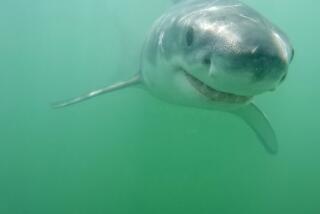Monterey Aces the Great White Shark Ethics Test
- Share via
Since mid-September, the Monterey Bay Aquarium has been mobbed by fish fans (and “Jaws” fans) who want to see its newest inhabitant: a young, female great white shark. But the aquarium’s critics have been lining up as well. They say the shark should be released, that it should never have been put on display in the first place.
Why all the fuss over keeping a great white shark in captivity? Because it’s a first.
On Sept. 15, the aquarium made history when the shark fed in the exhibit tank. On Oct. 1, the aquarium set the record for keeping a great white shark alive in captivity. The previous mark was 16 days; now it’s 47 and counting.
The great white shark -- or white shark, as scientists prefer -- is the largest flesh-eating shark in the sea, found and feared worldwide along cool coastal waters and even the warmer waters of Hawaii and the Mediterranean. As adults, white sharks feed on seals and sea lions, and occasionally on surfers and swimmers. (In August, a diver was killed by a white shark off the Mendocino coast, the latest in California’s known toll of 10 white shark deaths.) But despite its ferocity, it is a threatened, elusive species, a fragile fish that has defied those in the United States, Australia and South Africa who have tried to house, study and display it.
The bugaboo relates to the fact that white sharks, unlike most other sharks, must swim in order to “breathe.” Continuous swimming allows oxygenated water to cross its gills; if it stops, it suffocates. Capturing, holding or transporting a white shark (adults typically weigh a ton) usually means death for the fish.
The Monterey Bay Aquarium spent three years and more than $1 million on a two-part study of white sharks off Southern California, tagging, tracking and observing them in the wild, and testing methods for safely holding smaller, younger individuals.
The research team also educated fishermen about the program, and it was a “bycatch” female yearling -- 4 feet, 4 inches and 62 pounds, carefully tended by a Huntington Beach fisherman -- that survived collection in August, recovered from the trauma in the project’s halfway house (a 4-million-gallon, open-ocean pen off Malibu), graduated to a “swim-in-place” transportation tank, and now resides in the Outer Bay exhibit tank in Monterey. The shark’s well-being was continuously assessed. Had it faltered, it would have been released.
Why go to all this trouble? The aquarium’s harshest critics would have you believe it’s all about money, putting a shark on display to cash in on the “Jaws” fascination. But as mythic as white sharks are for humans, we know very little about them, and the opportunity for continuous, accurate observation will fill gaps in our knowledge that radio-tagging, baiting shark cages and observing in the wild can’t hope to fill -- growth and feeding-rate data, for instance, or, for our own protection, data on which wet-suit colors attract their attention.
The ethical test for any zoo or aquarium has to be the same for white sharks as it is for salamanders or slime mold: if it cannot be kept alive it should not be kept. That idea was the foundation of the aquarium’s shark project; nothing in its handling of the shark shows any retreat from that standard.
As for the issue of display, I believe that seeing is learning. White sharks are predators that play a key role in coastal ecology, yet they are rapidly disappearing from the world’s oceans, and humans are to blame. We trade in their teeth, jaws and fins; we catch them and their prey; and we demonize them, which clears the way for their slaughter.
But this shark has been winning over the crowd at the aquarium since the day it made its debut. “I’m not creeped out anymore,” a 10-year-old convert told a reporter last week.
Swimming gracefully and peaceably in its tank among giant bluefin tuna, sea turtles, other shark species and 2,000 sardines, it benignly refutes its ominous reputation. It’s the best ambassador sharks could have.
More to Read
Sign up for Essential California
The most important California stories and recommendations in your inbox every morning.
You may occasionally receive promotional content from the Los Angeles Times.










